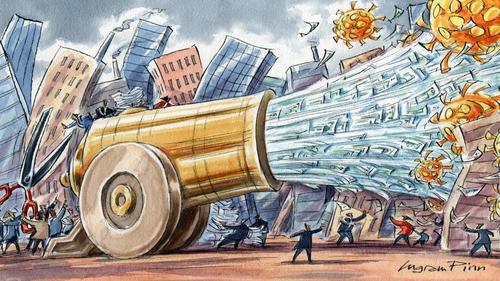Financial Repression 101
Authored by MN Gordon via EconomicPrism.com,
Bad ideas are flourishing like Washington lobbyists. Just look around. It’s near impossible to blink without countless crackpot ideas coming into view. What’s more, the worse an idea is, the more popular it becomes.
Take Mickey’s Fine Malt Liquor. It’s almost as destructive as doctor prescribed pain killers. Yet people chug down Big Mouths as if their lives depend on it.
Or consider central banking. Has any other single idea extracted more wealth from the lowly wage earner? The Federal Reserve’s backdoor taxation program has snookered honest hard-working Americans for over 100 years.
Why is it that bad ideas are so warmly received? Perhaps, it’s because they generally promise something for nothing. That one can live off the forced philanthropy of their neighbors. That one can get more out of their retirement fund than they put in.
Promises of fruits without labors are fantastical. They’re also the reliable way for politicians to get reelected. How can it possibly be a good idea to spend more and tax less, and fill the gap with more and more debt?
From a sound fiscal and currency management perspective this is a terrible idea. Certainly, a policy to spend less and tax less would be much sounder. But for a politician looking to win votes, promising something for nothing is the only way to go.
Politicians know Americans generally do the exact opposite of what they say. They may say they’re against bigger government. But they will always vote in their self-interest, especially if they think they’ll get something for nothing.
They’ll always vote for promises of government handouts if they believe they won’t have to pay for them.
Popular Delusions
Bad ideas can also appear in the form of what 19th century author Charles Mackay first called “extraordinary popular delusions and the madness of crowds.” With little rhyme or reason masses of people will pile into something ridiculous…before they quickly pile out.
One day it’s Beanie Babies. The next day it’s Dogecoin.
Visions of fast and easy riches cloud the ability for clear and honest contemplation. The popular delusion all spring was that a great economic boom had arrived. First quarter gross domestic product (GDP) growth reached 6.4 percent. Good times were within reach.
The rationale generally followed… The economy’s reopening. Businesses are hiring. Summer is nearing. Pent up demand and excess stimmy cash are coalescing into a great big consumption binge.
Stocks and cryptocurrencies were being bid up to unfathomable heights by the madness of crowds. Yet, at the same time, price inflation, propelled by mass money printing, began making an unwanted appearance in everything from grapefruits to gasoline. Broken supply chains also brought scarcity to everything from computer chips to chicken wings.
Could it be that market anticipation of a great economic boom is nothing more than an extraordinary popular delusion?
As Mackay elaborated long ago:
“Men, it has been well said, think in herds; it will be seen that they go mad in herds, while they only recover their senses slowly, one by one.”
This week, one by one, men – and women – appeared to slowly recover their senses…if only for a moment. Stocks and cryptocurrencies rose and fell like an amusement park rollercoaster.
But if people truly come to their senses there’s plenty of downside to go. After hitting an intraday all-time high of 14,211 on April 29, the NASDAQ is only down 4.75 percent. And the S&P 500’s only off 1.86 percent from its all-time high.
What to make of it…
Financial Repression 101
Every rational inkling tells us stocks will be lower a year from now. But what if they’re higher?
Stranger things have happened. For example, we thought the great Treasury bond bubble had peaked over a decade ago. Yet, through extreme credit market intervention, yields continued to slump and slide well into 2020.
And while the 10-year Treasury yield has been creeping up over the last 9 months, real – inflation adjusted – interest rates have never been lower. In fact, analysis by Mish reveals the real interest rate is -4.09 (minus 4.09) percent. Moreover, when national housing prices are factored into the inflation adjustment, real interest rates are -5.47 (minus 5.47) percent.
Real negative interest rates are a product of the Fed’s extreme credit market intervention. This, folks, is financial repression 101.
In short, through Fed policies of financial repression (i.e. pegging short term interest rates below the inflation rate), Washington is able to extract wealth from your bank account and future earnings to indirectly pay down public debts. The government steals growth from the economy through zero interest rates and money printing to inflate away government debt.
Pretty slick trick, right?
Unfortunately, this type of monkey business produces financial bubbles and busts…and wreaks havoc on the economy.
These real negative interest rates, along with extraordinary popular delusions, are what’s behind the rampant inflation in both asset and consumer prices.
So what gives? Is the stock market rolling over? Or is this merely a modest correction before stocks uncork to even more dizzying heights?
We suppose anything’s possible when monetary and fiscal policy makers are conspiring to devalue the dollars in your bank account…
…and that’s the real story here. The story you must keep in focus…
The books are being reckoned via the printing press. It’s happening, right now, at this very moment…and it will continue for many years to come.
Better get used to the madness.
Tyler Durden
Fri, 05/21/2021 – 15:01
via ZeroHedge News https://ift.tt/2Sia109 Tyler Durden
